U.K. company makes and even grows components as it strives to create the most environmentally friendly bed
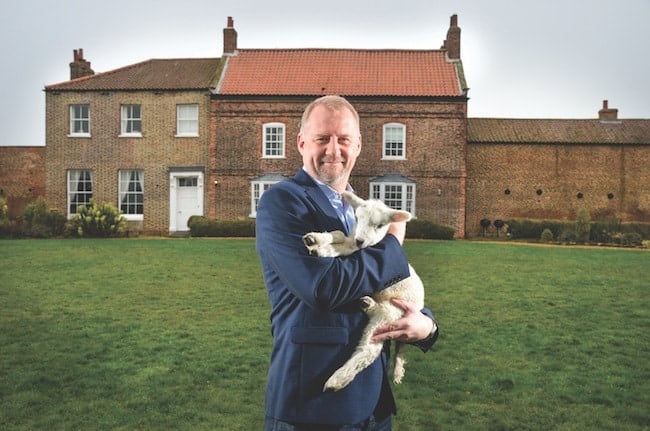
FARM TO FACTORY Harrison Spinks’ Managing Director Simon Spinks poses with one of his flock outside Hornington Manor in North Yorkshire, England. The company, based in Leeds, England, bought a 300-acre farm in 2009 to raise sheep for wool, as well as grow flax and hemp.
Simon Spinks, managing director of Leeds, England-based luxury bed and component producer Harrison Spinks, believes his company has developed an innovative spring technology that has the potential to transform the bedding industry.
That’s a bold claim, but not without precedent. After all, it was Harrison Spinks that changed the spring segment in 1996 with the introduction of its Revolution coil-within-a-coil technology. The design positions one small spring inside a larger one, offering variable levels of support. The outer spring creates a high degree of comfort, while the inner spring delivers support to heavier areas of the body. Under license, Leggett & Platt Inc. markets the system as Joey, named for a baby kangaroo, which spends its infancy nested in its mother’s pouch. The coil system is featured in all Harrison Spinks bed models, as well as the mattress collection the company manufactures for British retailer John Lewis.
It also was Harrison Spinks that developed the bedding industry’s first microcoils, introducing them in 2010. Microcoils are smaller and lighter than typical innerspring coils, allowing bed makers to put a dense layer of coils in the cushioning material, where they help minimize body impressions and enhance comfort. In 2012, Harrison Spinks licensed the technology to Hickory Springs for sale to bed makers in the United States. Hickory Springs’ microcoils are marketed under the Posturfil brand.
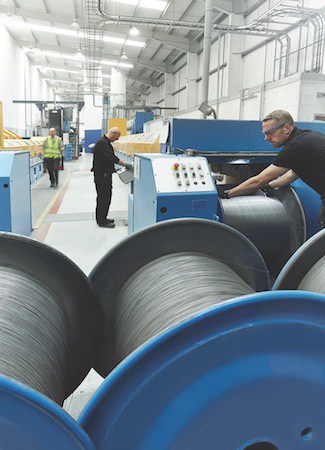
WIRED In late 2014, Harrison Spinks began drawing its own wire from steel rod for use in its springs.
Now Harrison Spinks is preparing to debut a groundbreaking spring system that is so “strong, supportive and comfortable” that a sleeper could lie down and get a good night’s sleep on it without any additional fillers or foam layers, Spinks says. The new system is undergoing final testing before being launched late this year or in early 2019.
“We have discovered that if you increase the coil count and reduce the gauge of the wire, the surface becomes very soft,” Spinks says. “The wire gets so fine it becomes fiberlike but still has resilience and strength. It doesn’t need much on top of it to be comfortable.”
In Spinks’ view, the new technology would enable both bedding and upholstery manufacturers to reduce the amount of foam they put into mattresses and cushions. In certain constructions, he says, it could eliminate the use of foam.
“We’re pretty convinced that, as an industry, we shouldn’t be gluing things together if we can avoid it,” Spinks says. “In addition, there are lots of good reasons to reduce the amount of waste we generate, both during production and when a product reaches the end of its life. While foam can be reused as backing for carpet or another purpose, it can’t be recycled like springs. Steel springs can easily be melted down and become a fridge door or some other product.”
The ‘electric car’ for bedding
For all these reasons, Spinks sees his company’s new spring technology as having the potential to be an inflection point for home furnishings in the same way that electric cars eventually may replace gasoline-
powered vehicles. “If the range of an electric car is good enough and the price is competitive, it’s game over for petrol,” Spinks says. “Most people in the industry believe that day is coming—it just hasn’t happened yet.”
Like Tesla’s pioneering advances with electric cars, Harrison Spinks has been working for some time on new technologies to create a more environmentally friendly bed, Spinks says. “We want to not only use natural, locally sourced materials, but also remove chemicals and glue from our products,” he says. “A mattress that is foam free, glue free and chemical treatment free that can be totally recycled is our ultimate goal.”
Harrison Spinks’ new wire technology—code named Ultra—represents a big step in that direction, Spinks says.
The technology for the Ultra project was developed in-house by a team of 20 engineers and designers. The team’s mission, Spinks says, is to “think about tomorrow’s products—how they’re made, how they’re used and what happens to them at the end of their lifespan. That’s the part of our business that excites me the most. We always have our eye on the future. We want to keep pushing the limits of what is possible.”
The company’s research team started years ago with a small group “just messing about and trying to improve our machinery,” Spinks says. “Over the years, we’ve come up with a lot of our own equipment—and other innovations—that have improved our production process, as well as our beds.”
The team is not afraid to make mistakes, Spinks adds. “That’s how progress is made,” he says. “As a family-owned company, we have the freedom and resources to investigate areas that interest us to see if they can be improved.”
Innovation is ingrained in the company’s culture. Harrison Spinks’ continuous investment in technology has allowed it to become what Spinks says is “the most vertically integrated bed manufacturer in the world.”
“This willingness to experiment is one of our biggest assets,” he says. Spinks adds that, unlike the typical company, Harrison Spinks’ vertical integration has been driven by a desire to foster innovation rather than a push to simply become more efficient. A born tinkerer and inventor, Spinks grew up with a proclivity for taking things apart to see how they work—and whether they can be made better.
“As an inventor, I take great pleasure in working with our development team to dream up new components and ideas to improve the sleeping experience,” Spinks says. “In addition, we’re always looking for ways that used materials can be recycled as a component for a new mattress or to create something else. Our goal is to have mattress making be part of the ‘circular’ economy, so nothing gets thrown away and wasted.” In a circular economy, resources are kept in use as long as possible, then recovered and regenerated into other materials and products at the end of their original lives.
In addition to Harrison Spinks’ “toy shed,” where product development takes place, the company also has an in-house laboratory used to test the quality of components and finished products, Spinks says. The lab contains a custom-made rollator and an indentation load deflector for mattress testing, as well as a tensile machine for wire analysis. The lab also boasts turbidity testing equipment to assess the cleanliness of wool fillings.
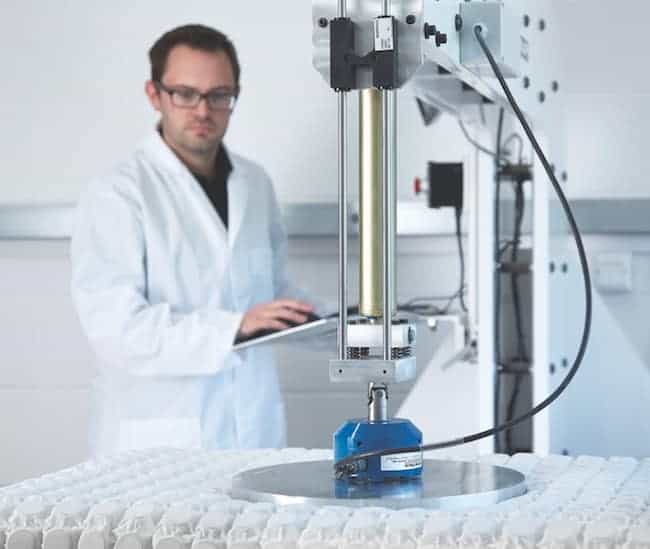
PRACTICE MAKES PERFECT A technician tests springs in Harrison Spinks’ lab.
Deep roots
The current Harrison Spinks company is a combination of two businesses—Harrison Spinks and Somnus Bedding—that ran independently of each other for more than a century before coming together in 2000, when Harrison Spinks acquired the rights to the Somnus brand. The two companies have another piece of shared history: Albert Parker (Simon Spinks’ great-grandfather) worked at Somnus as a young man in 1907. It is where he first learned how to make mattresses.
Somnus traces its roots to 1840, when William Rhodes launched a business providing flocked fabrics for the mattress industry. The Bedding House of Rhodes, as it was called then, expanded its line at the turn of the 20th century to include innerspring mattresses and eventually changed its name to Somnus Bedding after the Roman god of sleep and dreams. A leader in the U.K. bed market for many decades, Somnus is credited with two British bedding innovations—the “jiffy tuft” and “clipped pocket spring units.” In addition, some of Somnus’ ads are so iconic they are on display in the Victoria and Albert Museum in London.
Harrison Spinks got its start in 1885, when Arthur Spink (no relation to the Spinks family) joined forces with John Edgar, a salesman, and began making and selling beds as Spink & Edgar. In 1889, Spink & Edgar became known as Spink & Co. In 1925, Arthur Spink retired and left the company to Albert Harrison, his one-time apprentice. Harrison was joined by Albert Parker and the business partners formed A. Harrison Bedding Ltd. in 1933.
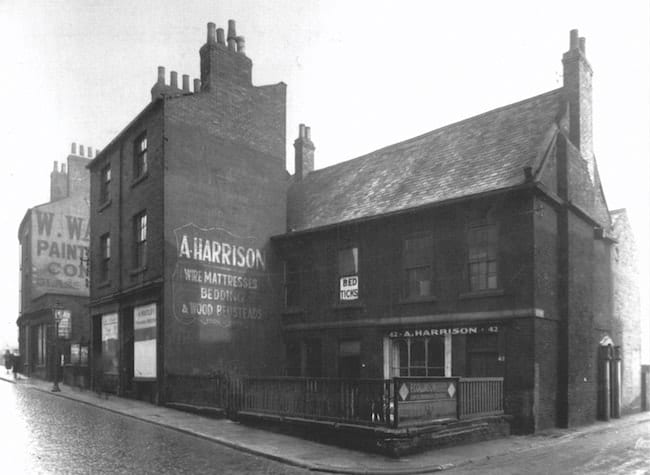
LONG HISTORY This is how the original A. Harrison mattress factory appeared in the 1930s. The company’s name was changed to Harrison Spinks in 2000.
In 1947, Harrison retired. Parker ran the business until he was succeeded by his son Les Parker and son-in-law Ron Spinks (Simon’s great-uncle and grandfather, respectively), who had married his daughter. Les Parker, an aspiring jazz musician, then sold the business in the 1970s to his nephew Peter Spinks (Simon Spinks’ father). To raise enough money for the purchase, Peter Spinks had to mortgage his house, as did his dad, Ron Spinks. In 2000, they changed the name of the company to Harrison Spinks.
Today, Simon Spinks is the company’s managing director and Peter Spinks serves as chair. Simon Spinks’ son, Daniel, works at the factory, learning the business from the ground up, just like his predecessors.
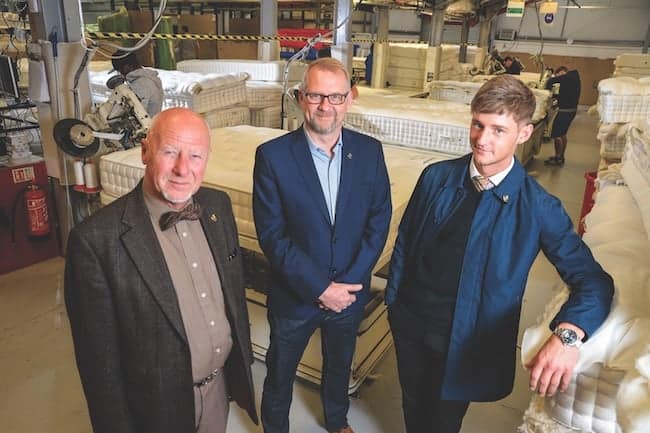
MULTIGENERATIONAL Peter Spinks (from left) serves as chair of Harrison Spinks, his son Simon Spinks has been managing director since 2000 and his grandson Daniel Spinks (Simons Spinks’ son) is working at the factory now, learning the business from the ground up.
“I am the fourth generation (of our family) to lead our company,” says Simon Spinks, who started working at the company at age 11 and joined it full time in 1989. “Dad achieved a great many things as managing director, particularly in the area of marketing and brand building. He shifted our focus from contract to the retail sector. But he also faced difficult challenges as a result of the slow-growth economy. He played a bad hand well since the business at that time didn’t have anything to differentiate itself.”
In 1995, Simon Spinks became operations director. That same year, after several years of research and development, the company secured the patent on its Revolution coil technology.
“We had been looking for a way to set ourselves apart,” Spinks says. “We started looking at how we might improve the pocket spring to make a more luxury-end product. We studied everything—Teflon coating, the silk pockets, you name it—to see what else might be possible.”
The idea to position a spring within a spring came from a car kit Simon built with his dad while a youth. “To stop valve bounce, you put a spring inside a spring, which allows you to rev the engine higher. I started to wonder whether the same principle might work in mattresses,” he says.
The answer was a clear “yes.” L&P bought the world rights to the newly patented technology, and Harrison Spinks kept the rights for the United Kingdom and Ireland. The enhanced spring system also enabled Harrison Spinks to introduce a new luxury brand with a link to its past—Spink & Edgar—and expand its reach into a more upscale segment of the market.
With Simon Spinks leading the charge on product development, more innovations followed and, in 2000, he became managing director. That same year, Harrison Spinks acquired the prestigious Somnus trade name, which the company reintroduced to the consumer market with a variety of collections in 2007.
“I had to convince my father to promote himself to chairman,” recalls Simon about his transition to managing director. “I was eager to run things and make my impact. I told him that by appointing me MD, I would be responsible for all the worrying and all he would have to do is give advice.”
The collaboration has proven to be a winning formula. Over the past few decades, Harrison Spinks’ annual sales have grown from less than $5 million in 1995 to $49 million in 2015. This year, sales will be about $80 million.
Homegrown success
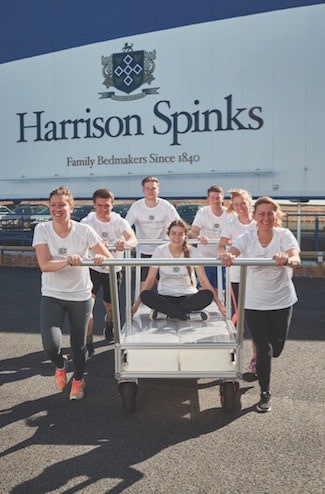
TEAM EFFORT Seven members of the company prepare to join the Great Knaresborough Bed Race, an annual charity event sponsored by the local Lions Club.
Of course, there have been bumps along the way. Probably the biggest test of Simon Spinks’ leadership came in 2009, when he came up with the idea of buying a 300-acre farm in North Yorkshire, about 20 miles from the company’s headquarters and factory in Leeds. The rationale? Spinks wanted his company to have its own source of natural mattress fillings, such as wool, flax and hemp.
“The board was nervous about spending £3 million on a farm, but my dad understood the value right away,” Spinks says. “I kept making my pitch and slowly they came around.”
A news release went out to the industry announcing the venture and, after that, there was no turning back. “We hadn’t even planted a seed, so we all had a huge learning curve,” Spinks says. “We eventually became very good at it, but in the early years, we barely could produce what we needed. We learned that desperation truly is the mother of invention.”
Today, the farm produces 30% of the natural materials used in the company’s mattresses. Half the acreage is used for growing flax and hemp; the other half serves as grazing pasture for 600 sheep. In all, 50% of the company’s mattress fillings are locally sourced in the United Kingdom. Some materials, such as Egyptian cotton and silk, only can be grown abroad. As it does for its beds, Harrison Spinks has created custom equipment to improve the productivity and sustainability of its farm.
“We don’t source our own materials because it’s easier, we do it because they enable us to make a better bed,” Spinks says. “The hemp from our fields is absorbent and naturally resistant to mildew, while the wool from our sheep regulates body temperature, keeping sleepers warm and snug in the winter and cool and comfortable in the summer.”
Because the farm property included a historic manor house, the Spinks family also expanded its business portfolio with another bold move. The house, built in 1770, has been restored and turned into an inn called Hornington Manor, which is rented out for weekend visits and weddings, in tandem with a converted barn on the property where parties can be held. During the week, the manor house often hosts retailers, suppliers and other business partners who come to the area to visit Harrison Spinks’ facilities. All rooms are furnished with the company’s luxury beds.
In 2011, Harrison Spinks acquired a 56-acre woodland in Sand Hutton, England. The company harvested its first trees from the responsibly managed forest this year, and the wood is being used to make bed frames and headboards.
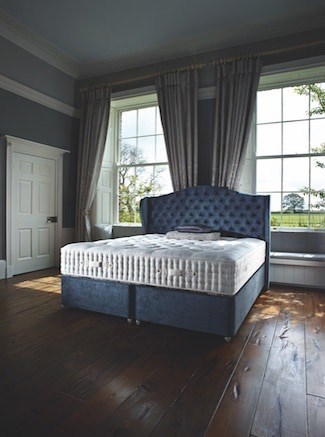
HANDCRAFTED BEDS The Spink & Edgar USA line is made under license in the United States but incorporates natural fillings from Harrison Spinks’ farm in North Yorkshire.
“We’re delighted that the hard work from our managers and ‘slumberjacks’ is coming to fruition,” Spinks says. “As the only bed producer in the world with our own farm and now our own forest, we can ensure the quality of the materials that go into our mattresses and other products is the very best and also reduce our carbon footprint, since these homegrown materials don’t have far to travel to get to our factory.”
Wherever possible, Harrison Spinks uses natural fillings because of their properties and luxurious comfort. “Our biggest customer in the U.K. asked us to pay more attention to sustainability a number of years ago, and that started us on a journey,” Spinks says. “It led us to make our beds greener and greener, to the point where nobody can make a bed the same way we can now.”
In 2013, Harrison Spinks was awarded two Queen’s Awards for Enterprise. One was for innovation and another was for sustainable development. This year, the company was honored once again with two Queen’s Awards for international trade and innovation. Harrison Spinks is the only bed maker to receive two Queen’s Awards in the same year on two occasions.
In 2015, Harrison Spinks was named Bed Manufacturer of the Year by the National Bed Federation, a U.K. trade association. Also in 2015, the company’s springs division was awarded the Interzum Intelligent Material and Design Award for its Posturflo 3D microspring technology during Interzum Cologne.
A family of brands
In England, Harrison Spinks’ line includes four bed brands: Harrison, handcrafted, pocket sprung beds; Somnus, which features the Sensa “intelligent” pocket spring system; Hybed, which combines memory foam, pocket springs, microcoils and natural fillings; and Spink & Edgar, a luxury microcoil construction. Harrison Spinks also has a line of crib mattresses called Harrison Spinks Baby, as well as a hospitality division.

SKILLED TAILORS Harrison Spinks prides itself on a long legacy of hand craftsmanship.
The company ranks as the top-volume producer in the upper one-third of the U.K. bedding market, according to Spinks.
In the United States, Harrison Spinks teamed up with Sibose (Sleep is Better on Spink & Edgar) in 2015 to launch Spink & Edgar USA, a line of luxury “farm to bedroom” mattress models. Sibose is a partnership between brothers Mark and Jeff Quinn, former L&P and Mattress Firm executives, respectively, and Neil and Lance Ellman of bedding manufacturer Sherwood Bedding. The beds are produced under license by Sherwood’s three U.S. factories and include natural materials sourced from Harrison Spinks.
The line starts with the Egyptian Cotton 3000 mattress, priced at $2,069 retail, which features one layer of 2,080 high-density Hickory Springs microcoils and three all-natural filling pads of Egyptian cotton, hemp and flax, topped by woven silk and cotton jacquard ticking. At the high end is the Angora 9000 model, priced at $4,069. It features four layers of HD microcoils, 1 inch of graphite-imbued latex and three all-natural filling pads of angora, alpaca, Yorkshire wool; Egyptian cotton; hemp and flax; topped by woven silk and jacquard ticking.
All four models are constructed with L&P’s Quantum Edge Perimeter innerspring unit, plus an all-natural hemp insulator pad. Each mattress comes with a wood Eurobase foundation coupled with a steel performance grid.
As is the case at Harrison Spinks’ factory in England, Spink & Edgar USA beds are handmade using traditional techniques. Retailers selling the line include Sit ’n Sleep, Gabberts, Gardner’s Mattress & More, Jordan’s Furniture, Moore’s Sleep World and SleepNation.
“In three years, Spink & Edgar has established relationships with some of the nation’s best retailers,” Spinks says. “Mark Quinn and his team have done a great job of building this new brand in the U.S. and creating awareness, and we expect this will grow into a substantial business for us over time.”
From wire to fabrics
In addition to its mattress lines, the Harrison Spinks Components division also supplies microcoil pocket springs under the Spinks Springs brand to bedding producers worldwide, as well as to upholstery, automotive, aviation and footwear companies. Since 2014, Spinks Springs has been drawing its own wire from steel rod in-house, a capability that enables it to produce thinner wire and smaller springs than are typically available.
“We decided to invest in our own wire-drawing capacity because we needed it to innovate,” Spinks says. “We had reached the limit of the materials we were working with until we added that capability. Our wire-drawing lines and unique drum coiler facilitates the drawing of wire as fine as 0.5 millimeters in diameter. High-carbon steel wire with diameters is very difficult to buy commercially because of the complexity of production. Producing our own wire in-house means we can stay ahead of the competition.”
Leading the way as Harrison Spinks expanded into this new business was Rich Essery, who joined the company from L&P. “When Rich came on board, that sparked a lot of new ideas,” Spinks says. “We began to think about wire and its role in a bed in a different way.”
This spring, Harrison Spinks expanded its wire-drawing capacity by installing two more lines in a 40,000-square-foot building in Scunthorpe, England, belonging to British Steel. These lines will draw the ultra-fine wire used to manufacture Harrison Spinks’ pocket springs. Over time, Harrison Spinks plans to add six more wire-drawing lines to the facility, for a total capacity of 400 tons of wire each week.
“This investment in this new wire-drawing facility is part of our wider business strategy to become world leaders in sustainable mattress and comfort innovation,” says Essery, managing director of Harrison Spinks Components. All of the steel waste from production will be recycled.
Similarly, Harrison Spinks installed two state-of-the-art weaving looms in 2015. “We invested in looms so we could develop our own chemical-free fabrics,” Spinks says.
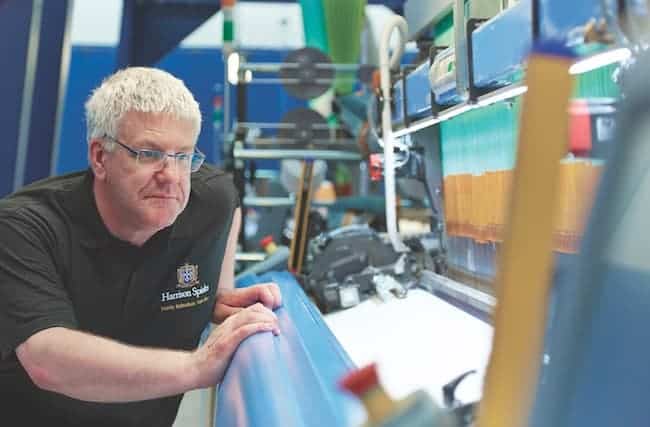
INNOVATIVE Harrison Spinks installed its own in-house weaving looms for making mattress ticking in 2015.
Today, Harrison Spinks weaves the majority of its mattress ticking in-house from a viscose fiber with inherent FR properties. “Producing our own FR ticking means there are less harmful chemicals used in the production of our mattresses, which is better for our health and for the environment, too,” Spinks says.
About his company’s relentless quest for improvement, Spinks says, “our mission is simple:
We want to deliver the world’s best sleeping experience.”





